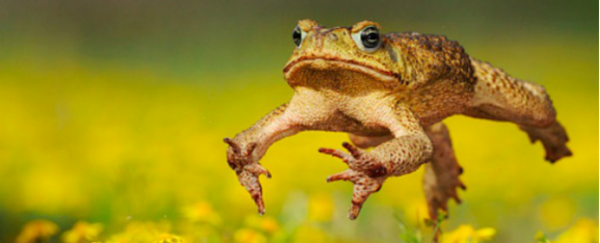Toads toe the straight and narrow path.
Cane toads, Australia's most diabolic invaders, have rapidly evolved to march in straight lines, dramatically speeding up their conquest of northern Australia as a result, scientists have found.
Toads in the Northern Territory now travel six times as fast as the offspring of early toad settlers in Queensland. Fascinatingly, 'straightness' has never been identified as a hereditary trait in any other animal species before.
Ecologist Dr Gregory Brown, a co-author of the study, told ScienceAlert that he suspected 'straightness' could actually be the rule rather than the exception in invasive animal species.
"Straight paths … might be a near-ubiquitous consequence of the process of range expansion," he said.
The research was published this month in the journal Proceedings of the Royal Society of Biology.
A team of scientists from the University of Sydney has been closely studying how cane toads evolved since they were introduced to Australia. Their previous work has shown that as the cane toads spread out from Queensland, the toads that were best adapted for dispersion reached the invasion front first and mated with other toads of high speeds and stamina, creating a 'master race' of toad invaders.
The breeding frenzy of super-toads at the invasion front hastened the toads' takeover by aggregating dispersal traits in the expanding population. The speed of the invasion has accelerated from 10-15 kilometres per year to over 60 kilometres per year.
The team of scientists quickly realised that toads travelling in straight lines were far more likely to reach the invasion front first, and hypothesised that this trait would be prominent in those at the invasion front as opposed to toad lineages that never made it past Cairns.
The team radio-tracked toads at one location every year since 2005 and showed that straightness was markedly higher in toad populations in the invasion vanguard than in toads who arrived later.
To investigate whether there was a genetic basis for this difference in path straightness, the researchers collected toads across the 1,600 km toad range and measured the path straightness of their offspring.
In their experiment the toad babies' paths were as straight or as wobbly as their parents, indicating that this trait is hereditary.
"[We think] that increased path straightness arises through some sort of neurological change … enabled by [an] enhanced ability to orient or navigate or perceive direction.
"Alternatively, all toads may have equal abilities to navigate and orient but it is only frontal toads that 'decide' to use this information to head in the same direction consistently," said Brown.
There are an estimated 200 million cane toads in Australia, all of which descended from around 100 toads that were introduced in northern Queensland in an effort to control the cane beetle pest in 1935.
Toads have wreaked ecological havoc in Australia since their introduction; they exude a poison called bufotoxin, which is deadly to many native Australian predators, and compete with native animals for resources. Efforts to control the cane toad population have so far been widely unsuccessful but new methods, which involve turning the toad's poison against itself to trap and suppress growth of tadpoles, are looking promising.
